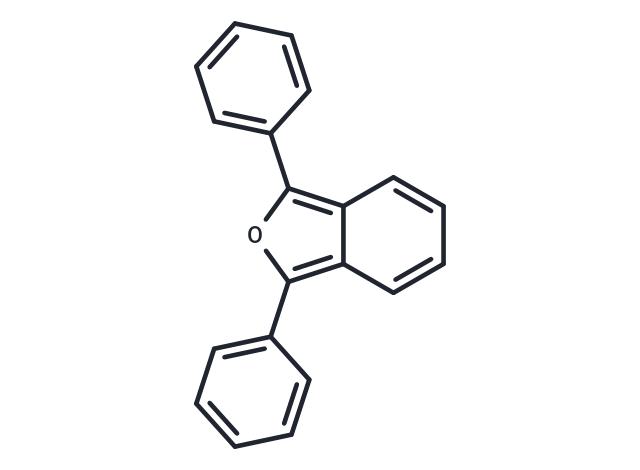Shopping Cart
Remove All Your shopping cart is currently empty
Your shopping cart is currently empty
1,3-Diphenylisobenzofuran (DPBF) is a fluorescent probe. It possesses a highly specific reactivity towards singlet oxygen forming an endoperoxide which decomposes to give 1,2-dibenzoylbenzene. 1,3-Diphenylisobenzofuran can detect the generation of reactive oxygen species (ROS).

| Pack Size | Price | USA Warehouse | Global Warehouse | Quantity |
|---|---|---|---|---|
| 500 mg | $30 | - | In Stock | |
| 1 g | $40 | - | In Stock |
| Description | 1,3-Diphenylisobenzofuran (DPBF) is a fluorescent probe. It possesses a highly specific reactivity towards singlet oxygen forming an endoperoxide which decomposes to give 1,2-dibenzoylbenzene. 1,3-Diphenylisobenzofuran can detect the generation of reactive oxygen species (ROS). |
| Cell Research | I. Cell fluorescence labeling a. Solution preparation: 1. Mother solution preparation: Prepare 10 mM DPBF mother solution with DMSO, store it at -20℃ or -80℃ in the dark after aliquoting. 2. Working solution preparation: Dilute the mother solution with preheated serum-free cell culture medium or PBS to prepare 10-20μM DPBF working solution (select the appropriate working solution concentration according to experimental requirements, and prepare it for immediate use). b. Operation steps: 1. Cell staining: Suspended cells: Collect cells by centrifugation, add PBS and wash twice, 5 minutes each time. Adherent cells: Discard the culture medium and add trypsin to digest the cells. After centrifugation and discarding the supernatant, add PBS and wash twice, 5 minutes each time. If you do not do flow cytometry experiments, adherent cells do not need to be digested. 2. Add DPBF working solution: Add 1mL DPBF working solution and incubate at room temperature for 30 minutes. 3. Centrifugal washing: 400g, 4℃ centrifuge for 3-4 minutes, discard the supernatant. Add PBS to wash the cells twice, 5 minutes each time. 4. Resuspension detection: After resuspending the cells with 1mL serum-free medium or PBS, detect under a fluorescence microscope or flow cytometer. 2. Superoxide anion detection a. Operation steps: 1. Dissolve the nanozyme and DPBF in PBS solution and prepare them to the required concentration. 2. Reaction system construction: Mix the prepared nanozyme and DPBF solution, place them in an appropriate reaction container, and incubate for 5 minutes. 3. Result detection: Use instruments such as UV-visible spectrophotometer or fluorescence spectrometer to measure the absorbance or fluorescence intensity changes of the solution before and after the reaction (excitation wavelength 410 nm, emission wavelength 455 nm) to evaluate the generation of superoxide anions. |
| Synonyms | DPBF |
| Molecular Weight | 270.32 |
| Formula | C20H14O |
| Cas No. | 5471-63-6 |
| Smiles | c1ccc(cc1)-c1oc(-c2ccccc2)c2ccccc12 |
| Relative Density. | 1.141 g/cm3 |
| Storage | keep away from direct sunlight,store under nitrogen,store at low temperature | Powder: -20°C for 3 years | In solvent: -80°C for 1 year | Shipping with blue ice/Shipping at ambient temperature. | |||||||||||||||||||||||||
| Solubility Information | DMSO: 6.94 mg/mL (25.67 mM), Sonication is recommended. | |||||||||||||||||||||||||
Solution Preparation Table | ||||||||||||||||||||||||||
DMSO
| ||||||||||||||||||||||||||
| Size | Quantity | Unit Price | Amount | Operation |
|---|

Copyright © 2015-2025 TargetMol Chemicals Inc. All Rights Reserved.